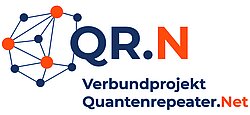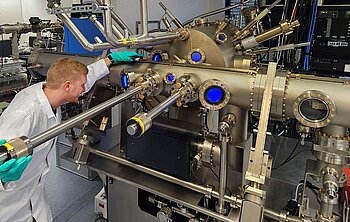Research
Introduction
The main research objectives of ‘Technische Physik’ are related to the fabrication and characterization of semiconductor nanostructures. The group works on the development of nanostructure patterning technologies for optoelectronic applications as well as for basic physics studies of low dimensional photonic and electronic systems.
A complete chain of processing equipment, ranging from molecular beam epitaxy over several lithographic techniques to etching and deposition systems is used to fabricate devices and nanostructures for spectroscopy and transport experiments. In addition to the cleanroom facilities, the group operates a wide range of characterization tools (optical spectroscopy, transport measurements, laser characterization, high frequency measurement, ..), which are used to investigate the performance of devices and fundamental aspects of low-dimensional structures.
The research is carried out in the framework of several national and international projects with numerous cooperations with universities, research centers and industry.
Cluster of Excellence
The Würzburg-Dresden Cluster Complexity and Topology in Quantum Matter (ctd.qmat) is a leading international center for research on topological and complex quantum matter. The aim is to develop a deep understanding of quantum phenomena in general and to identify materials in which those phenomena are observed in the laboratory.
QR.X
Quantenrepeater.Link (Teilvorhaben: Entwicklung von halbleiterbasierten Bausteinen für Quantenrepeater und deren Einsatz in Demonstrationsexperimenten)
Ziel des Verbundprojekts QR.X ist die erste Umsetzung von neuartigen Quantenrepeatern und deren Einsatz unter realen Bedingungen. Das Teilprojekt der Julius-Maximilians-Universität Würzburg beschäftigt sich mit der Entwicklung von halbleiterbasierten Bausteinen für Quantenrepeater und deren Einsatz in Demonstrationsexperimenten.
QR.N
Quantenrepeater.Net (Teilvorhaben: Entwicklung und Einsatz von halbleiterbasierten Bausteinen auf Grundlage von optisch aktiven, epitaktisch gewachsenen Halbleiterquantenpunkten für Quantenrepeater)
Ziel des Verbundprojekts QR.N, des Folgeprojekts von QR.X, ist die Demonstration von Quantenrepeater-Strecken mit Zwischenknoten, parallelen Quantenkanälen, verschränkungsunterstützter Kommunikation und Schnittstellen zwischen Quantenrechnern. Im Teilprojekt der Universität Würzburg entwickeln wir halbleiterbasierte Bausteine mit Quantenpunkten für Quantenrepeater. Hauptziele sind die Kopplung zweier Quantenrepeater-Segmente mit einer Quantenpunktmolekül-Zelle bei 900 nm und die direkte Erzeugung von Spin-Multiphoton-Verschränkung bei 1550 nm. Zudem stellen wir optimierte Einzelphotonenquellen für ein Quantenrechnernetzwerk bereit.

MHLASQU
Modengekoppelte Halbleiterlasern für die kohärente Kontrolle von Festkörper-Quantensystemen
Zur optischen Kontrolle von Qubits sind hocheffiziente Einzelphotonquellen auf der Basis von Quantenpunkten erforderlich, die im vorliegenden Projekt durch neuartige Kurzpulslaser mit optimal an die Einzelphotonquellen angepassten Eigenschaften erarbeitet werden. Die Julius-Maximilians- Universität Würzburg bringt ihre hohe Expertise in der Herstellung von Quantenpunkt-Lasermaterialien sowie der Einzelphotonenquellen in das Verbundprojekt mit ein.
PhotonQ
Measurement-based photonic quantum processors
Qecs
Quantenpunkte als deterministische effiziente Clusterzustandsquellen
Im Projekt Qecs soll zunächst eine verlässliche und helle Lichtquelle erstellt werden, um dann Clusterzustände mit vorerst drei und später bis zu 32 Photonen zu erzeugen. Der Kern dieser Lichtquelle wird ein sogenannter Quantenpunkt auf GaAs Substrat sein. In diesem Quantenpunkt werden gezielt einzelne Photonen erzeugt, die über Wechselwirkung mit lokalen Ladungsträgern verschränkt sind. Das schafft die Grundlagen für speicherfreie Quantenrepeater, die insbesondere in photonisch-basierten Quantencomputern zur Signalübertragung genutzt werden können.
QD-E-QKD
Quantum Dots for Entanglement-based Quantum Key Distribution
QD-E-QKD will develop a novel technology based on semiconductor quantum dots and test it in realistic urban communication scenarios to surpass the limits of current approaches to entanglement-based quantum key distribution. The University of Wuerzburg contributes to the collaborative project by developing high-quality epitaxial quantum dots and circular Bragg grating cavities for high photon rates.
QuNET+ ICLink
QuNET+ Deterministische Einzelphotonenquellen für faserbasierte Inter-City-Verbindungen

Das Projekt QuNET+ICLINK hat zum Ziel, neue Konzepte für leistungsstarke deterministische Einzelphotonenquellen (dEPS) im Telekom C-Band zu entwickeln und deren Eignung für die Quantenkommunikation über große Entfernungen und die perspektivische Integration von Quantenrepeatern in ein quantensicheres Behördennetz zu validieren.
Das Projekt adressiert den Bedarf an „Deterministischen Einzel- und Multi-Qubit Quellen“ und die Entwicklung skalierbarer und kostengünstiger Ansätze für spektral reine dEPS im Telekom-Wellenlängenbereich und fördert zudem die Zusammenarbeit mit QR.X-Partnern zur Integration von Zukunftstechnologien in QuNET.
PoQuaHonta
Positionierte Quantenpunkte für Hochskalierung von Quellen verschränkter Photonen für den Einsatz in Quantentechnologien
Halbleiter-Quantenpunkte sind vielversprechende Quellen für ununterscheidbare und verschränkte Photonen mit hoher Effizienz, Ununterscheidbarkeit und Fidelität. Diese Eigenschaften sind essenziell für Anwendungen wie Quantenkryptographie, Quantencomputing und Quantenmetrologie. Die Integration mehrerer Quantenpunkte mit höchster Materialgüte in Resonatoren stellt jedoch eine große Herausforderung dar, da die Positionen der spontan geformten Quantenpunkte zufällig ist. Quantenpunkte oft qualitativ überlegen sind.
Ziel des Forschungsprojekts PoQuaHonta ist es, deterministisch platzierte Quantenpunkte qualitativ gleichwertig zu spontanen Quantenpunkten zu machen, bei höherer Ausbeute und kontrollierter Positionierung. Dies ermöglicht den Betrieb mehrerer Photonquellen auf einem Chip. Dafür untersuchen wir Wachstumsmethoden zur Optimierung der Wellenlängenhomogenität und Photonengüte, was grundlegende Materialforschung erfordert.
RIBKD
Resonante Interbandkaskaden-Infrarotdetektoren für photonische Sensorikanwendungen an Gasen, Flüssigkeiten und Festkörpern (Teilvorhaben: Epitaxie von in optischen Kavitäten integrierten Interbandkaskaden-Infrarotdetektoren)
Ziel des Verbunds ist die Entwicklung von MIR-Detektoren, die etwa zehnmal empfindlicher als HgCdTe-Detektoren und zugleich umweltfreundlich sind. Dazu werden Interbandkaskadendetektoren in Resonatorstrukturen integriert, um den Dunkelstrom zu reduzieren und die Quantenausbeute auf über 95 % zu steigern. Die dünnen Quantenschichten des Absorbermaterials werden dabei zwischen zwei Spiegel eingebettet. Die Detektoren werden in Modellanwendungen an Schlüsselgasen im medizinischen und Nahrungsmittelbereich getestet.
Ziel des Teilvorhabens der Universität Würzburg ist die Entwicklung Ga-freier Interbandkaskaden-Photodetektoren (IC-Photodetektoren) mit Integration in eine optische Kavität basierend auf BRAGG-Spiegeln. Durch die Kombination von Kaskadierung und reduziertem Absorbervolumen wird das Detektorrauschen minimiert, während die Kavität die notwendige Quanteneffizienz gewährleistet, was die Detektivität im Vergleich zu anderen Plattformen deutlich steigert. InAs/InAsSbx Schichtstrukturen simuliert, epitaktisch gewachsen und iterativ analysiert. Die Bauelemente, wie BRAGG-Spiegel und IC-Photodetektoren, werden final zu einem innovativen, in Kavitäten integrierten Detektor kombiniert.

Freistaat Bayern
Funded by the Free State of Bavaria:
IQ-Sense
Integrated Spin Systems for Quantum Sensors
The lighthouse project IQ-Sense is funded by the Free State of Bavaria within the framework of Munich Quantum Valley and aims to develop quantum sensors for application in biology and medicine.
See press release (in German).
InPWAMLOB
InP-basierende weit abstimmbare monolithische longitudinal einmodige Laser für die optische Blutalkoholdetektion
Im Rahmen des Bayerischen Verbundforschungsprogramms (BayVFP), Förderlinie "Digitalisierung" des Freistaats Bayern, entwickelt der Lehrstuhl für Technische Physik der Universität Würzburg gemeinsam mit Skyline Photonics neuartige, abstimmbare InP-basierte Laser zur präzisen Blutalkoholmessung. Diese Laser sollen als Kernkomponente von Wegfahrsperren dienen, die das Starten eines Fahrzeugs bei Überschreiten des Alkohol-Grenzwertes verhindern. Das Projekt zielt auf die Umsetzung einer innovativen Sicherheitslösung mit weitreichenden Anwendungen in der Verkehrssicherheit und medizinischen Diagnostik.
European Union (EU)
Funded by the European Union:
Quantimony
Quantum Semiconductor Technologies Exploiting Antimony
Fostering industrial and academic research across Europe in quantum semiconductor materials for Telecomm, Datacomm and Photovoltaics.
Quantimony is a European project funded by the European Union’s Horizon 2020 research and innovation programme under the Marie Skłodowska-Curie grant agreement n° 956548.
PROTEMIC
Integrated Spectroscopy for Protein Analysis Using Metasurfaces and Interband/Quantum Cascade Devices
PROTEMIC focuses on protein analysis as proteins are the fundamental building blocks of life. Modern medicine and the pharmaceutical industry have an unmet need for dynamic, in-situ monitoring of structural changes of proteins to increase therapeutic effectiveness, reduce immunogenicity and increase product shelf life.
PROTEMIC is a Double Doctorate Training Network that brings together the disciplines of Physics, Analytical Chemistry and Biochemistry to determine protein structure from a sample’s Mid Infrared absorption spectrum without the use of labels or reagents.
PROTEMIC, co-ordinated by MTU, will train 12 PhD students who will receive a double PhD degree awarded by two host universities. The project comprises 10 partners across Europe, namely: Munster Technological University, Technische Universität Wien (Austria), Nanoplus Gmbh (Germany), InsuCaps Ltd (Ireland), Tyndall National Institute-UCC (Ireland), Instituto de Investigación Sanitaria La Fe de Valencia (Spain), Fraunhofer IAF (Germany), Julius-Maximilians Universität Würzburg (Germany), Universitat de València (Spain) and Paul Scherrer Institut (Switzerland).
DIRAQUM
Dirac Photonic Metamaterial for Quantum Light Sources
Technology in photonic quantum information processing and quantum computing is advancing rapidly, demanding more efficient control of quantum light generation. Semiconductor quantum dots (QDs) have emerged as leading photon sources due to their high emission rates. However, achieving both high photon indistinguishability and extraction efficiency remains challenging due to trade-offs between photon control and collection efficiency, as well as material limitations. Integrating quantum dots with Dirac photonic metamaterials offers a promising solution, leveraging topological states and enhanced light-matter interactions to improve performance.
The aim of this project is to combine quantum dots (InGaAs) with Dirac photonic metamaterials to achieve specific goals, including high photon indistinguishability, efficient photon extraction, and tailored single-photon emission.
Keywords:
materials engineering; optical engineering, photonics, lasers; optics, including laser optics and quantum optics; quantum optics and quantum information; solid state materials; quantum dot, single-photon sources, photonic metamaterial, Dirac cone, quantum optics

Deutsche Forschungsgemeinschaft (DFG)
Funded by the German Research Foundation:
HO 5194/12-1
Kondensate und Transistoren basierend auf halbleitenden organischen-inorganischen Hybridpolaritonen
KL 3124/3-1
Elektrisch betriebene, topologische Exziton-Polariton-Laser
HU 2985/1-1
Mikrolaser-angeregte Quellen ununterscheidbarer Photonen für Quantennetzwerke
FI 947/6-1
German Israeli Project Cooperation (DIP): Bright sources of quantum light for efficient entanglement distribution
HO 5194/16-1
Kollektiver Quantentransport und licht-assistierte Supraleitung
KL 3124/6-1
Eine integrierte Halbleiterplattform für die Implementierung und Untersuchung von Exzeptionellen Punkten höherer Ordnung
HO 5194/19-1
Konstruktion und Manipulation von topologischen Isolatoren aus III-V-Heterostrukturen
HU 2985/2-1
Fasergekoppelte GaSb-Quantenpunkt-Quellen mit abstimmbaren Einzelphotonen für die Quantenschlüsselverteilung im Feldeinsatz
KL 3124/12-1
Blochoszillationen von Exziton-Polaritonen in topologischen Gittern














